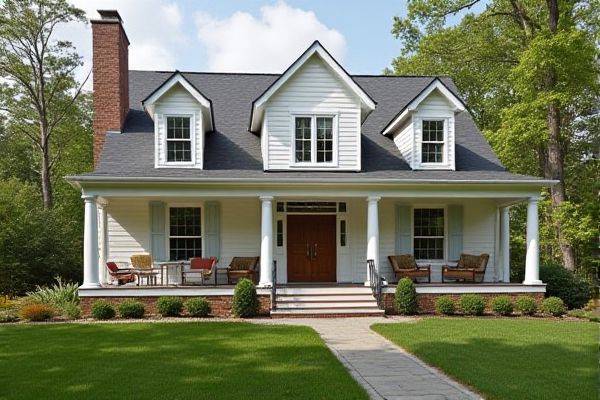
A wraparound porch extends around multiple sides of your home, offering extensive outdoor living space and enhancing curb appeal, while a partial porch covers only a single section, providing a smaller, more intimate area for relaxation. Explore the rest of the article to discover which porch style best suits your home's design and your lifestyle needs.
Table of Comparison
| Feature | Wraparound Porch | Partial Porch |
|---|---|---|
| Definition | Porch that extends around two or more sides of the house | Porch limited to one side or front of the house |
| Size | Larger, covers multiple sides | Smaller, covers one side only |
| Functionality | Offers multiple outdoor seating areas and views | Provides a single outdoor sitting or entry space |
| Architectural Style | Common in Victorian, farmhouse, and Southern homes | Typical in modern and bungalow styles |
| Cost | Higher due to larger area and materials | Lower, less materials and construction time |
| Maintenance | More effort due to larger surface area | Less maintenance required |
| Property Value | Often increases curb appeal and market value significantly | Offers moderate enhancement to property value |
Introduction to Porch Styles
Wraparound porches extend along multiple sides of a home, providing expansive outdoor living space that enhances curb appeal and offers panoramic views. Partial porches cover only a portion of the facade, delivering a cozy entry area or small sitting spot while requiring less construction and maintenance. Homeowners often choose between wraparound and partial porches based on architectural style, intended use, and budget.
What Is a Wraparound Porch?
A wraparound porch is a spacious, continuous porch that extends around two or more sides of a home, enhancing both curb appeal and outdoor living space. This design typically connects the front and side entrances of a house, offering panoramic views and ample room for furniture and decor. Unlike a partial porch, which usually covers just a small section near the front door, a wraparound porch maximizes usable outdoor areas and provides versatile functionality for relaxation and social gatherings.
Defining a Partial Porch
A partial porch is a covered outdoor space attached to a specific section of your home's facade, typically extending from the front door or a side entry, providing shelter and a cozy seating area. Unlike a wraparound porch, which encircles two or more sides of the house, a partial porch covers only a limited portion, making it more compact and easier to maintain. Choosing a partial porch can enhance your home's curb appeal while offering a designated space for relaxation without the extensive construction or upkeep of a full wraparound design.
Curb Appeal and Aesthetic Differences
A wraparound porch enhances curb appeal by providing a continuous, inviting space that seamlessly integrates multiple sides of your home, creating a balanced and expansive aesthetic. In contrast, a partial porch offers a more compact design, often emphasizing a specific entryway without extending around the structure, resulting in a focused but less dynamic visual impact. Your choice will influence the overall architectural harmony and the welcoming feel of your home's exterior.
Usable Space: Wraparound vs. Partial
Wraparound porches offer significantly more usable space compared to partial porches, extending along two or more sides of a home and providing multiple areas for seating, dining, and outdoor activities. Partial porches are limited to one side or section of the house, restricting the usable outdoor living area and potential for varied functional zones. Your choice between wraparound and partial porches directly impacts the amount of versatile, sheltered outdoor space available for relaxation and entertainment.
Construction Costs Compared
Wraparound porches typically incur higher construction costs than partial porches due to increased materials, labor, and design complexity involved in extending across multiple sides of a home. Partial porches require fewer structural components and less decking, making them more budget-friendly and quicker to build. Your choice between these porch types impacts overall expenses, with wraparound designs offering expansive outdoor space at a premium price point.
Maintenance and Durability Factors
Wraparound porches generally require more maintenance due to their larger surface area exposed to weather elements, increasing the need for regular cleaning, painting, and repairs. Partial porches, being smaller, offer enhanced durability by minimizing exposure to rain, wind, and sun, which reduces wear and tear over time. Your choice between these options should consider the balance between aesthetic appeal and the long-term upkeep effort you are willing to invest.
Functional Benefits for Homeowners
Wraparound porches provide homeowners with enhanced outdoor living space, offering multiple entry points and extended shade that improves comfort and usability throughout the day. Partial porches deliver focused protection at a single entrance, making them ideal for compact homes or specific outdoor seating areas. Both designs increase curb appeal and can boost property value by enhancing functionality and aesthetic appeal.
Resale Value and Market Appeal
A wraparound porch significantly boosts resale value by enhancing curb appeal and providing expansive outdoor living space, attracting homebuyers looking for charm and versatility. Partial porches offer a modest increase in market appeal but may not create the same visual impact or functional benefits as full wraparounds. Your investment in a wraparound porch can yield higher returns by differentiating your home in competitive real estate markets.
Making the Right Porch Choice for Your Home
Choosing between a wraparound porch and a partial porch depends on your home's architectural style and outdoor living needs. Wraparound porches offer extended outdoor space that enhances curb appeal and provides multiple seating areas, while partial porches provide a cozy, focused area ideal for smaller properties or budget-conscious projects. Consider factors such as available yard space, desired functionality, and maintenance requirements to make the best porch choice for your home's aesthetic and lifestyle.
 homyna.com
homyna.com